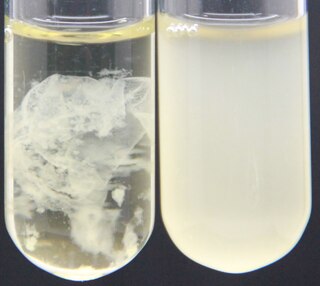The Aquificae phylum is a diverse collection of bacteria that live in harsh environmental settings. The name 'Aquificae' was given to this phylum based on an early genus identified within this group, Aquifex, which is able to produce water by oxidizing hydrogen. They have been found in springs, pools, and oceans. They are autotrophs, and are the primary carbon fixers in their environments. These bacteria are Gram-negative, non-spore-forming rods. They are true bacteria as opposed to the other inhabitants of extreme environments, the Archaea.

Enterobacterales with its type genus Enterobacter is an order of Gram-negative bacteria.

The Nitrosomonadales are an order of the class Betaproteobacteria in the phylum "Proteobacteria". Like all members of their class, they are Gram-negative.

The Rhizobiales are an order of Gram-negative Alphaproteobacteria.

The Rhodocyclales are an order of the class Betaproteobacteria in the phylum "Proteobacteria". Following a major reclassification of the class in 2017, the previously monofamilial order was split into three families:

The Burkholderiaceae are a family of bacteria included in the order Burkholderiales. It includes some pathogenic species, such as Burkholderia mallei (glanders) and Burkholderia pseudomallei (melioidosis).
Cronobacter is a genus of Gram-negative, facultatively anaerobic, oxidase-negative, catalase-positive, rod-shaped bacteria of the family Enterobacteriaceae. They are generally motile, reduce nitrate, use citrate, hydrolyze esculin and arginine, and are positive for L-ornithine decarboxylation. Acid is produced from D-glucose, D-sucrose, D-raffinose, D-melibiose, D-cellobiose, D-mannitol, D-mannose, L-rhamnose, L-arabinose, D-trehalose, galacturonate and D-maltose. Cronobacter spp. are also generally positive for acetoin production and negative for the methyl red test, indicating 2,3-butanediol rather than mixed acid fermentation. The type species of the genus Cronobacter is Cronobacter sakazakii comb. nov.
The Chloroflexi or Chlorobacteria are a phylum of bacteria containing isolates with a diversity of phenotypes, including members that are aerobic thermophiles, which use oxygen and grow well in high temperatures; anoxygenic phototrophs, which use light for photosynthesis ; and anaerobic halorespirers, which uses halogenated organics as electron acceptors.
Pitekunsaurus is a genus of titanosaurian sauropod dinosaur from the Late Cretaceous Anacleto Formation of Neuquén, Argentina. It was described by L. Filippi and A. Garrido in 2008. The type species is P. macayai. The generic name is derived from Mapudungun pitekun, meaning "to discover", the epitheton honours the discoverer, oil company explorer Luis Macaya, who found the fossil in April 2004.

The Haemosporida are an order of intraerythrocytic parasitic alveolates.
Ixorheorida is an order within the subclass Conoidasida of the phylum Apicomplexia. All members of this order are parasitic protozoa.

The Haemoproteidae are a family of parasitic alveolates in the phylum Apicomplexa.
Ixorheis is a genus of parasitic alveolates in the phylum Apicomplexa.
Merogregarina is a genus of parasitic alveolate in the phylum Apicomplexa. Species in this genus infect marine invertebrates.
The Diplocystidae are a family of parasitic alveolates in the phylum Apicomplexa.
The Ganymedidae are a family of parasites in the phylum Apicomplexa.
Acrocoelus is a genus of alveolates.
Perkinsozoa is a proposed phylum of intracellular parasites in the superphylum Alveolata, which was suggested to account for the genus Perkinsus and other protist species that do not fit into existing Alveolata phyla.
Lymphotropha is a genus of parasitic alveolates in the phylum Apicomplexa.
Apicystis is a genus of parasitic alveolates of the phylum Apicomplexa.





